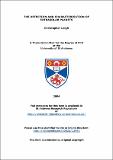The detection and characterisation of extrasolar planets
Abstract
Since the discovery of 51 Pegasi b in 1995, continued observations have indirectly identified over 110 planetary objects. These Jupiter-mass objects cause their host star to "wobble" slightly about the common centre-of-mass of the system, which is detectable as radial motion in high-precision Doppler spectroscopy. Of the known planets, approximately 20% are found to orbit within 0.1 AU of the star, whilst the transit of HD209458 has inferred the gas-giant nature of these close-in extrasolar giant planets (CEGPs). The discovery of CEGPs has produced a wave of speculative theory as to the exact nature of these objects, and how they came to exist so close to their parent star. Our spectroscopic technique provides a method of achieving the direct detection of a CEGP atmosphere, the results of which will allow us to test emerging models that aim to predict the atmospheric nature of CEGPs and may provide additional information on the orbital inclination and mass of the planet.
We start with a historical review of the field of extrasolar planets, followed by an introduction to the fundamental concepts which underpin the reflection of starlight from a planet's surface. We then investigate the prospects of detecting such a reflection, before detailing the technique we have devised and applied here to two known CEGP hosts.
In the first instance, r Bootis, we combined observations at the 4.2-m William Herschel telescope in 1998, 1999 and 2000. The dataset comprised 893 high-resolution échelle spectra with a total integration time of 75hr 32min spanning 17 nights. We establish an upper limit on the planet's geometric albedo p < 0.39 (at the 99.9% significance level) at the most probable orbital inclination i ~ 36 deg, assuming a grey albedo, a Venus-like phase function and a planetary radius Rp - 1.2RJup. Although a weak candidate signal appears near to the most probable radial velocity amplitude, its statistical significance is insufficient for us to claim a detection with any confidence. In the second instance, HD75289, 4 nights of VLT(UT2)/UVES observations were secured in 2003 Jan, yielding 684 high-resolution spectra with a total integration time of 26 hours. We establish an upper limit on the planet's geometric albedo p < 0.12 (to the 99.9% significance level) at the most probable orbital inclination i ~/= 60 deg, assuming a grey albedo, a Venus-like phase function and a planetary radius Rp = 1.6RJup. In both cases, we are able to rule out some combinations of the predicted planetary radius and atmospheric albedo models with high, reflective cloud decks.
Type
Thesis, PhD Doctor of Philosophy
Collections
Items in the St Andrews Research Repository are protected by copyright, with all rights reserved, unless otherwise indicated.

